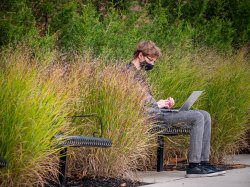Non-pharmaceutical Interventions for COVID-19 Proved Most Effective When Universally Adopted, Studies Show
Professor co-authored two studies looking at mitigation strategies in U.S. and China
Posted in: Press Releases, Research, Science and Technology

Before COVID-19 vaccines were made available to the public, stay-at-home orders and other non-pharmaceutical interventions (NPI) proved most effective when they were adopted universally – but new research shows prediction models should account for how individual locations will react to different mitigation strategies in order to make them most effective.
Two research studies led by Montclair State University Professor of Earth and Environmental Studies Danlin Yu assessed the impact and effectiveness of NPI strategies in both China and in the U.S. in early 2020.
Published in the scientific journal Applied Geography, the studies, titled “Seeing the Forest and the Trees: Holistic View of Social Distancing on the Spread of COVID-19 in China” and published in the journal Annals of the Association of American Geographers, “Governance Policy Evaluation in the US During the Pandemic: Non-pharmaceutical Interventions or Else?” confirmed the efficacy of NPI strategies on flattening the curve and made recommendations for investigating the measures on both a macro and micro level in the hopes of informing future policy decisions.
Judging the Impact of COVID-19 Policy Adoption
Results of the study in China showed the primary contributing factors for the daily spread of COVID-19 were the intensity of inner-city travel, the intensity of daily migration and workplace closure.
Similarly, in the U.S., interventions including stay-at-home orders, restaurant and bar limits, large gathering bans, non-essential business closures and mask-wearing mandates were significant predictors of decreasing cumulative cases, new cases and death rates of COVID-19.
Where the results differ is in the adoption of these NPI. In China, universal adoption led to sharper declines, while in the United States, these drops were seen more prominently in states that saw higher and more wide-spread adoption levels.
Striking a balance between science and politics is a delicate science of policy and governance, Yu says. “We hope the results from these studies will not only provide practical policymaking support for policy makers on the ongoing fight against COVID-19, but also create a platform for discussion regarding the delicate balance between fighting a global pandemic and maintaining socioeconomic normalcy.”
Adjusting COVID-19 Modeling for the Future
Most models and predictions that have previously been used to investigate NPI are built on the premise that the strategies will work universally, regardless of locations that have varied degrees of the virus and spread, as well as social, economic, demographic and natural conditions.
“The spatiotemporal analytical strategies presented in both studies attempt to tackle the subtlety of the complex spatiotemporal variation that is inherent in many phenomena we observe everyday,” Yu says. “At the end of the day, it is always the subtle details that determine the general trend we see. It is our job to decipher these details and present their working trajectory so we understand the general trends better, and make better decisions based upon these analyses.”
While these are effective in the early stages of an outbreak, these studies indicate that more local-level analysis – particularly at the state and even municipality level in the United States – should be conducted to better inform policy discussions.
